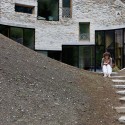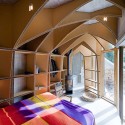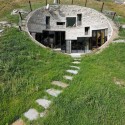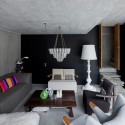Monday, December 14. 2009
Cooling the Asphalt Jungle
The asphalt jungle is due for a makeover as tar beach becomes a sanctuary for native plants, wildflowers and winged pollinators. Like mushrooms after a spring rain, "green roofs" are proliferating on rooftops across the United States and throughout Europe, gaining adherents among sustainable design advocates intent on creating more livable and greener cities.

"Green roofs" are proliferating on rooftops across the United States and throughout Europe, gaining adherents among sustainable design advocates intent on creating more livable and greener cities.While rooftop gardens have been a part of city life since the 19th century (if not earlier), their environmental benefits are just beginning to be fully realized. As global temperatures creep upwards, scientists are glancing at the skyline, looking for ways to cool down concrete-bound cities and the planet. One proposal has been to install white roofs, which would reflect solar heat and require less energy to cool urban areas. Another idea is to absorb — or sequester — heat-trapping gases like carbon dioxide by using rooftops as yards.
In a first-of-its-kind study, researchers at Michigan State University have calculated the carbon sequestration benefits extensive green roofs can provide. Findings from horticulturalists Kristen Getter and Brad Rowe in October's Environmental Science & Technology revealed green roofs' potential as carbon sinks.
During photosynthesis, plants remove carbon dioxide from the atmosphere and store CO2 in the leaves, soil and root system, converting sunshine into carbon-based compounds such as carbohydrates and sugar. According to Environmental Protection Agency statistics, U.S. forests sequestered 637 million metric tons of the carbon dioxide emitted by made-sources such as coal, fuel and natural gas. Urban forests sequestered on average an additional 74 million metric tons. (All told, the U.S. offsets about an eighth of the carbon it produces, and the vast majority of the offset comes from forests.)
Currently the job of large-scale carbon sequestration is performed in the vast storehouse of the Earth's ocean and forest ecosystems that play an integral part in regulation of the temperature of the atmosphere.
While there have been studies on how much heat green roofs might fend off, how well a green roof would store carbon had been uncertain up until Getter and Rowe's study.
Two experiments were run to measure the potential of storing carbon in green roofs. The first involved eight green roofs in Michigan and four in Maryland ranging from 1 to 6 years of age. The second involved planting an extensive green roof of 20 1-square-meter plots at MSU's campus in East Lansing.
All the green roofs were planted with Sedum, a genus of leafy succulent known for its hardiness and often used as ground cover. "We planted what we knew would grow," said Getter.
Over a two-year period, the plants on the East Lansing campus were periodically harvested. Leafy parts stored on average 168 grams of carbon per square meter, the roots and the soil respectively stored 160 and 300 grams on average. Combined, each plot had the capacity to store 375 grams of C02 per square meter.
The researchers estimated the city of Detroit has 219 acres of roof space available for conversion. If black tar roofs were retrofitted, 55,000 tons of CO2 could be removed from the air — enough CO2 to offset the carbon emissions of 10,000 mid-sized SUVs or trucks for an entire year, they calculated.
"Implementing a green roof strategy would definitely be one way of managing the sequestration of carbon," said Getter. And yet ... in order to offset man-made carbon emissions it would require a Texas-sized green roof to make a significant contribution to carbon sequestration.
"Green roofs certainly don't store the kind of carbon that a forest or productive grassland stores, but a traditional roof is essentially a wasteland — no carbon storage whatsoever," Getter wrote via e-mail.
Jim Mumford, a horticulturalist turned entrepreneur, is dubious about the amount of carbon sequestration a green roof provides. Perceiving it as an added but minor benefit, "it's debatable about how much of a carbon sink it really is," he said.
Still, he's in total agreement there has to be more green and less tar on city rooftops. In 2007, he retrofitted his office with a 478-square-meter green roof, the first of its kind in San Diego, if not the state.
As the founder of GreenScaped Building, he's completed construction on nine green roofs in San Diego County and has several more projects under proposal throughout California and the United States.
Instead of talking meters and grams, Mumford is faced with the challenge of turning data into a business plan. He believes retrofitting commercial space with green roofs in Southern California is cost-prohibitive, especially in the current business climate. For the time being, "building has ground to a halt," he said.
Once the market revives, the next challenge he faces will be building large-scale green roofs at a price real estate developers and building owners will pay. Green roofs cost typically twice as much to install as conventional roofs.
Nonetheless, he's intrigued. "The more I looked at it the more excited I got," he said. Mumford envisions a day when installing a green roof will be part of a comprehensive plan to create buildings that are both energy efficient and conserve water.
He's assembled living walls and demonstrated water-caching systems on the grounds of his business complex, transforming his workplace into an "open laboratory" for water and energy conservation strategies, and seeking cost-effective ways to capture rainwater rather than rely on drinking water to irrigate green roofs.
Burnishing a building with a living skin has several environmental advantages. Most notably, it cuts down on storm water runoff, reducing the energy costs associated with heating and cooling buildings, and extends the material lifespan of roofs exposed to the elements.
Inside his office, Mumford has noticed a marked difference. White noise has been reduced. He's saved 23 percent on his electric bills. And rather than redoing his roof every 10 to 20 years, he believes his green roof can last up to 60 years if maintained properly.
A study by the Berkeley Lawrence Lab found that if 15 percent of the buildings in Los Angeles installed reflective or green roofs, daytime temperatures would be reduced by 3 degrees Celsius — saving Los Angeles half to 1 gigawatt of power during peak-use hours.
"There is a tremendous movement in other cities," said Mumford as he rattled off the names of cities where interest in green roofs has grown exponentially. That has to be good news for keeping cities cooler and green-thumbed entrepreneurs.
As green roofs proliferate to cool and cheer cityscapes, might they also suck up and store some of the carbon urban life pumps out?
-----
Via Miller - Mc Cune
Thursday, December 10. 2009
Villa Vals / SeARCH & CMA
Architects: SeARCH & CMA
Location: Vals, Switzerland
Design: Bjarne Mastenbroek & Christian Müller
Interior design cardboard bedroom: Studio JVM, Jeroen van Mechelen
Interior design excluding cardboard bedroom: Bjarne Mastenbroek
Interior advises: Christian Müller, Monica Ketting & Thomas Eyck
Contractor main structure: Kurt Schnyder Bauunternehmung, Vals, CH
Structural engineering: Alex Kilchmann, Schluein, CH
Glass façade engineering and construction: Walch GmbH, Ludesch, AT
Carpenter, interior finishing: A. Gartmann AG, Vals, CH
Cardboard interior: Nedcam shaping technology, Apeldoorn, NL
Cupboards, step chest: van hier tot Tokio’, Japanese Antiques
Electrical installations: Comet GmbH, Vals, CH
Plumbing & Water installations: Oscar Caduff, Vals, CH
Mechanical Ventilation & heating regeneration: Lippuner EMT AG, Grabs, CH
Avalanche protection: Geobrugg AG, Romanshorn, CH
Fire places and stoves: Maurus Cathomas, Ilanz, CH
Project Year: 2009
Photographs: Iwan Baan
Shouldn’t it be possible to conceal a house in an Alpine slope while still exploiting the wonderful views and allowing light to enter the building?
Surprised that it was permissible to construct a pair of dwellings so close to the world famous thermal baths of Vals, the client seized the opportunity to develop the site, without disturbing the bath’s expansive views. The introduction of a central patio into the steep incline creates a large façade with considerable potential for window openings. The viewing angle from the building is slightly inclined, giving an even more dramatic view of the strikingly beautiful mountains on the opposite side of the narrow valley.
The Local Authority’s well intentioned caution, that unusual modern proposals were generally not favoured, proved unfounded. The planners were pleased that the proposal did not appear ‘residential’ or impose on the adjacent baths building. The scheme was not perceived as a typical structure but rather an example of pragmatic unobtrusive development in a sensitive location. The placing of the entrance via an old Graubünder barn and an underground tunnel further convinced them that the concept, while slightly absurd, could still be permitted.
Switzerland’s planning laws dictate that it is only possible to grant a definitive planning permission after a timber model of the building’s volume has first been constructed on site. This can then be accurately appraised by the local community and objected to if considered unsuitable. For this proposal, logic prevailed and this part of the process was deemed to be unnecessary.
-----
Via ArchDaily
Related Links:
Personal comment:
A new strange "something" in Vals! ;)
Monday, December 07. 2009
De-Territorialised Milieus
Hear Philippe Rahm explain his recent project, "De-Territorilised Milieus," in this short animated film. With their grant from the VIA, Rahm, Quentin Vaulot, and Goliath Dyère developed furniture that appeals to the senses and reinterprets the geographic "spirit of the place." The project is a sustainable energy retrofitting, but also represents, more significantly, an anthropological approach to architecture.
-----
Via Jargon, etc.
Friday, December 04. 2009
900 Words About Sustainability
The Jargon ETC team is finally publishing our comprehensive post on sustainability. We hold the issue quite dearly here at the blog, but have never gotten to a public definition. Given that sustainability is currently the hottest issue in architectural circles thanks to recent inciting articles by Amanda Baillieu and the upcoming Copenhagen Summit on Climate Change, we feel like now is the opportune time to address the issue.
In the articles below each of our contributors talk about sustainability 300 words. Each author addresses their opinion on its definition and the larger implications of sustainability.
Read it all and give feedback with comments.
----------
Mr. Cuellar
By "sustainable," I understand a productive ecological approach that has no degenerative impact on the earth's natural, chemical life-based cycles and finite resources. The conventional means for achieving sustainable architecture are strictly functional: the building must meet these requirements, expend this little water, contain so much recycled material, etc.
Defining our sustainability strategy as functional would be to ignore the scope and imaginative potential of the issue. Many aspects of building, food production, transportation, and our very societies are unsustainable, and recent waves of eco-paranoia only make this more clear. Sustainability concerns every aspect of our daily lives, therefore the solution to managing resource consumption should, too.
Socially, we are at once bombarded by energy-saving tips and accustomed to long, hot showers.
Psychologically, we face "eco-angst."
Morally, it's difficult to decide whether the perversion of nature is "wrong" or irrelevant, interesting and subject to further perversion.
Politically, we are encouraged to trade in our clunkers, but suburban homeowners' associations forbid street-facing PV panels.
Practically, how could we possibly know for sure whether organic produce from overseas is more sustainable than pesticide-coated local fruit?
The misstep of architects would be to assume that meeting energy and spatial standards alone can cure the germ of today's ecological problems, let alone address our complex habits of consumption.
I propose a temporal and geographical solution, a nomadism, part Johnny Appleseed, part wi-fi addict. Debord's notion that nomads endure a "content less freedom" is helpful to understand the proposal (The Society of the Spectacle, New York, Zone Books, 2006 edition). We can suppose sedentariness produces content (a content-full captivity), but this is obviously unsustainable today. We mustn't adopt new typologies, but radicalize our existing ones. There must be living rhythms and situations, beyond and behind our artificial gardens of Eden, that agitate normalization and make the earth's outside environment fertile and flexible again.
----------
Mr. Grey
There are two leading approaches to architectural sustainability. The first view of sustainability is as an architectural a priori, no different from structure, materials or occupancy. This is the approach which leads to critical solutions and an understanding of entropy. The other approach is that of continual accretion. This second option, used by an army of LEED certified practitioners and advocated by figures as prominent as President Obama, believes that the application of more solar, wind, insulation, and geothermal is the solution to make something sustainable. These answers are built on the myth of capital production as the solution to any obstacle. Despite its wide acceptance, sustainable people should be skeptical of the ‘more’ solution.
The ‘more’ argument has a long history in the West. Children are taught that the Soviet Union collapsed because of the weight of overwhelming amounts of capital production in the West. Likewise, mass production is credited with overcoming the ‘Wild West,’ defeating fascism in Europe, and birthing a semi-autonomous middle class.
Now, facing a climate crisis, the ‘more’ solution resumes its typecasting. Architects embrace the more ideology for its marketability. Large allocations for solar and plant covered buildings dominate current built form and school pedagogies. These can be sold to clients in Dubai or New York without ever thinking about the real differences between these places.
More solutions always parallel the exponential growth patterns of capitalism. There is nothing sustainable about exponential models. Natural entropy is part of any critical sustainable solution; this directly involves architecture, and harks to old precedents.
This architecture, considering the climate a priori, was noted by Vitruvius, shown in the primitive hut by Laugier in 1804 and again by Frank Lloyd Wright. This architecture stops building 'more' for the sake of reparation. It creates critical architecture that requires pursuit of material, form, psychology, and ideology to offer a critical approach to sustainability.
examples : + and -
(+) Laugier: Primitave Hut Wright: Taliesen West Zumthor: Thermal Baths Roche: Hybrid Muscle
(-) Piano: Vulcano Buono SOM: Pearl River Tower DWELL magazine: Normandy Chapel
----------
Mr. Langevin
Environment as Sustainability
The question of sustainability is a question of environment. “Environment” (or some form of the term) has long been part of the public consciousness, beginning in the 1960’s with Rachel Carson’s Silent Spring, continuing into the 1970’s with the conservation movement, and remaining relevant to current discussions about climate change and global warming. While the general understanding of “environment” has evolved during these decades, the exploration of the distinctly human type of environment has lagged behind, stymied by the practice of standardizing the atmospheres that our buildings provide. Going forward, attempts to redefine these unsustainable built environments will provide the basis for a real sustainable revolution.
The word “environment” describes a complex network of interdependent variables that change across time and space. Variability is crucial in establishing an environment’s capacity for diversity, flexibility, and adaptability, all of which are tenets of fundamentally sustainable systems. Earth’s natural environment acts as one such variant ecosystem on a large scale, transforming by day and season in a cyclical process that continues on indefinitely into the future.
Since the advent of air-conditioning, the human environment has been uniquely divorced from the notion of variability, striving instead for predictability through strict mechanisms of control. Standardization has neutralized the climatic context of buildings by defining an artificially tempered interior that can be implemented in any corner of the world, provided a big enough HVAC system and tight enough exterior envelope. In these spaces, the occupant is deterministically reduced to the passive recipient of prescribed target conditions.
A sustainable human environment cultivates lower human energy use, higher sensory engagement, and increased productivity by integrating with surrounding ecosystems and embracing internal variability. Drawing from the diurnal and seasonal transformations of the natural climate, the environment acts as its own smaller ecosystem that evolves over time in a similarly cyclical manner. Efforts to achieve this atmospheric dynamic within a building are rare and difficult to pursue, as the addiction to climate control runs deep and is firmly entrenched in prevailing codes and guidelines. Nevertheless, they provide an essential challenge to the human environments most responsible for mankind’s dissonance with the Earth, and in doing so access the heart of the answers to the sustainability question.
-----
Via Jargon, etc.
Related Links:
Personal comment:
"The word “environment” describes a complex network of interdependent variables that change across time and space. Variability is crucial in establishing an environment’s capacity for diversity, flexibility, and adaptability, all of which are tenets of fundamentally sustainable systems. Earth’s natural environment acts as one such variant ecosystem on a large scale, transforming by day and season in a cyclical process that continues on indefinitely into the future."
and further away:
"The word “environment” describes a complex network of interdependent variables that change across time and space. Variability is crucial in establishing an environment’s capacity for diversity, flexibility, and adaptability, all of which are tenets of fundamentally sustainable systems. Earth’s natural environment acts as one such variant ecosystem on a large scale, transforming by day and season in a cyclical process that continues on indefinitely into the future."
These are quotation from "Mr. Langevin" to which I quite agree and that make me think to what we tried to "pinpoint" (the airconditioning as a non variable functional and comfortable environment) in the project RealRoom(s). It also make me think of another research project about space variability we worked on: Variable environment, even if this one is not really focused on sustainability. It could be a side aspect of it, I think in particular of Rolling Microfunctions"
fabric | rblg
This blog is the survey website of fabric | ch - studio for architecture, interaction and research.
We curate and reblog articles, researches, writings, exhibitions and projects that we notice and find interesting during our everyday practice and readings.
Most articles concern the intertwined fields of architecture, territory, art, interaction design, thinking and science. From time to time, we also publish documentation about our own work and research, immersed among these related resources and inspirations.
This website is used by fabric | ch as archive, references and resources. It is shared with all those interested in the same topics as we are, in the hope that they will also find valuable references and content in it.
Quicksearch
Categories
Calendar
|
|
December '09 |
|
||||
| Mon | Tue | Wed | Thu | Fri | Sat | Sun |
| 1 | 2 | 3 | 4 | 5 | 6 | |
| 7 | 8 | 9 | 10 | 11 | 12 | 13 |
| 14 | 15 | 16 | 17 | 18 | 19 | 20 |
| 21 | 22 | 23 | 24 | 25 | 26 | 27 |
| 28 | 29 | 30 | 31 | |||






















